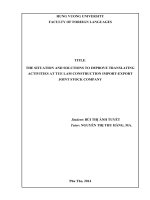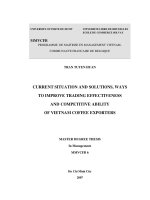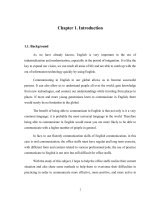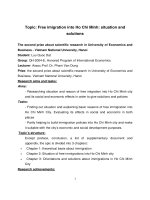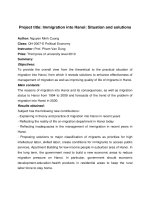36 ANALYZING FINANCIAL STATEMENTS AT VIETCOMBANK; SITUATION AND SOLUTIONS
Bạn đang xem bản rút gọn của tài liệu. Xem và tải ngay bản đầy đủ của tài liệu tại đây (501.68 KB, 55 trang )
MINISTRY OF FINANCE
ACADEMY OF FINANCE
-----�⧫�-----
Student : Thiều Quang Hưng
Group
: CQ55/51.01
GRADUATION THESIS
TOPIC:
“ANALYZING FINANCIAL STATEMENTS AT VIETCOMBANK;
SITUATION AND SOLUTIONS”
Major:
English for Finance and Accounting
Student code: 17522202010014
Supervisor:
Tran Huong Giang (MA.)
Hanoi – 2021
MINISTRY OF FINANCE
ACADEMY OF FINANCE
-----�⧫�-----
Student : Thiều Quang Hưng
Group
: CQ55/51.01
GRADUATION THESIS
TOPIC:
“ANALYZING FINANCIAL STATEMENTS AT VIETCOMBANK;
SITUATION AND SOLUTIONS”
Major:
English for Finance and Accounting
Student code: 17522202010014
Supervisor:
Hanoi – 2021
2
Tran Huong Giang (MA.)
Academy Of Finance
Graduation Thesis
DECLARATION
I declare that this undergraduate’s thesis “Analyzing finance statement in
Vietcombank; Situation and Solution” is the result of individual study and
self-experience research which is not replicated work.
The data and the material used in this thesis have clear sources and references
to all the sources. The result of this thesis is honest and derived from the
actual situation of the organization.
3
Thiều Quang Hưng
CQ55/51.01
Academy Of Finance
Graduation Thesis
ABSTRACT
The purpose of this thesis is to analyze the financial situation through the
analysis of financial statements of Vietcombank. In this thesis, we will learn
about Vietcombank's business performance in the 3 years from 2018 to 2020
to see what achievements they have achieved and how to develop direction.
At the same time, what difficulties did you encounter in the course of business
operations, and how to overcome them?
4
Thiều Quang Hưng
CQ55/51.01
Academy Of Finance
Graduation Thesis
ACKNOWLEDGEMENT
In order to complete this undergraduate’s thesis, I owe many people many
thanks for their supporting.
First, I would like to express my endless thanks and gratefulness to my
supervisor MA. Tran Huong Giang. Her kindly support and continuous advice
went through the process of completion of my thesis.
So far, I would like to thank all the lectures and staffs of Faculty of Foreign
Languages – Academy of Finance for their teaching and supporting me to
achieve knowledge and experience.
My special thanks to all staffs and management joint stock commercial bank
for foreign trade of Viet Nam–Hoan Kiem sub-branch; for their kind
assistance and support in providing me data and advice to complete the
research.
Finally, I would like to express my special thanks to my parents for their
endless love and motivation
Thank you!
5
Thiều Quang Hưng
CQ55/51.01
Academy Of Finance
Graduation Thesis
LIST OF FIGURES AND TABLES
FIGURES
6
Thiều Quang Hưng
CQ55/51.01
Academy Of Finance
Graduation Thesis
TABLE OF CONTENTS
7
Thiều Quang Hưng
CQ55/51.01
Academy Of Finance
Graduation Thesis
INTRODUCTION
1. Rationales:
Vietnam's economy is in the stage of development and integration with the
world economy with Vietnam becoming the 150th member of the World
Trade Organization (WTO). With the trend of integration, the banking sector
is always the backbone, one of the important industries with a long-term
development and making significant contributions to the development of the
national economy. Vietnam is starting to commit to opening up, making the
banking industry facing increasingly fierce competition, with many
opportunities but also many challenges. Facing such difficulties, it forces
joint-stock commercial banks to proactively analyze strengths, weaknesses,
opportunities and challenges to keep up with the changing environment. In
such conditions, the financial statements with the most integrated financial
information are the means to provide useful information for all subjects in a
competitive and developing market economy. Financial statement analysis is
the shortest way to approach the full picture of the financial situation of your
own bank, see both the pros and cons as well as the causes of those
weaknesses in order to have a correct business orientation in the future.
Over the past years, the Vietnamese commercial banking system has been
interested in financial assessment and analysis in the business process.
However, the assessment and analysis of commercial banks are still weak and
lacking reflected in the incomplete analytical methods, methods of review and
assessment, and evaluation criteria of the financial status of banks. This
makes it difficult for bank administrators to manage, evaluate and make
important decisions. This greatly affects the development of the banking
system in the future.
8
Thiều Quang Hưng
CQ55/51.01
Academy Of Finance
Graduation Thesis
Over the past 58 years of construction and development, Vietcombank has
made important contributions to the stability and development of the country's
economy, upholding its role as a major foreign bank, effectively serving
economic development, while at the same time making an important impact
on the regional and global financial community. However, along with the
immaturity of the financial and monetary market of Vietnam in general and
the Bank for Foreign Trade in particular, compared to developed countries in
the world, Vietcombank's financial statement analysis is also in in an early
stage of development with many limitations. For this reason, I decided to
choose the topic: “Analyzing financial statements at Vietcombank; Situation
and solutions” for my graduation thesis with the hope of contributing a small
part of my effort to perfecting the analysis of financial statements at
Vietcombank in particular and in the system of commercial banks in general.
2. Research purposes and missions:
It can be said that the analysis of the report in general has helped
administrators have a deeper insight into service performance, concretize into
‘talking numbers. Thereby providing timely, and effective strategies. At
Vietcombank in particular, the analysis of the financial statements is a
rewarding job and has clearly shown the importance in policy and strategy
planning of the managers.
Regarding the advantages of analyzing financial statements in commercial
banks, through research I have drawn some of the following characteristics:
The analysis of financial statements has mentioned almost all the indicators
on the financial statements such as growth of outstanding loans, capital
mobilization,… many criteria have been analyzed in many directions and
aspects.
Many banks are very strong in investing in information technology software
systems, which help to automate many reports and the data, information, …
9
Thiều Quang Hưng
CQ55/51.01
Academy Of Finance
Graduation Thesis
needed to be used for fast, complete and accurate analysis of financial
statements.
At Vietcombank, the financial statements are fully analyzed due to the
financial analysis department specializing in the analysis and evaluation.
Through the above advantages and disadvantages, I have drawn the research
purposes and tasks of the topic:
Firstly, researching this topic helps me systematize and clarify theoretical
knowledge about analyzing financial statements of commercial banks.
Secondly, researching the topic helps me to analyze in depth the situation of
financial at VCB in recent years.
Finally, researching this topic helps me propose some solutions to complete
financial development in VCB.
3. Scope and object of study:
The research object of the topic is financial statements and financial situation
at Vietcombank.
The scope of the research topic is analysis of financial statements through
criteria and contents of analysis of basic business operations of Vietcombank
in the period from 2018 to 2020.
4. Method of study:
The thesis uses statistical methods, synthesis and analysis with a system of
diagrams and tables to present theoretical and practical contents.
10
Thiều Quang Hưng
CQ55/51.01
Academy Of Finance
Graduation Thesis
Chapter 1: LITERATURE REVIEW
1.1.
OVERVIEW OF FINANCE STATEMENT AND ANALYSIS OF
FINANCIAL STATEMENTS
1.1.1. Overview of finance statement:
1.1.1.1. Concept of financial statements:
The financial statements system includes special documents which are
standardized according to the international accounting system in principles
and standards. Financial statements are an important part of the annual report
of commercial banks. The reason financial statements are a system is because
people want to emphasize the close and organic relationship between them.
Each separate financial report provides readers with a different useful aspect,
but it is not possible to obtain generalized results on the financial position
without a combination of financial statements. Academically, the financial
statements are defined as “a system of tables, describing information about
the financial situation, business and cash flows of the business. Financial
statements include consolidated reports on assets, equity and liabilities as
well as the financial position and business results in the period of the
enterprise”. In other words, financial statements are a means to present the
profitability and the current financial situation of the business to those who
are interested.
1.1.1.2. The role of the financial statements:
Financial statements play a great role in banks' business operations, which can
be clearly seen through the following basic features:
The financial statements are presented in an overview, reflecting the total
assets, capital resources as well as the entire financial situation of the bank in
the form of numbers to help readers grasp the most intuitive operation of the
bank during the period.
11
Thiều Quang Hưng
CQ55/51.01
Academy Of Finance
Graduation Thesis
The financial statements are intended to provide necessary information for the
administrators of commercial banks and other business objects, such as:
shareholders, senior managers.
Financial statements provide major economic and financial information to
evaluate the situation and results of production and business activities, the
financial status of commercial banks, to help check and monitor the use of
capital and mobilization of capital in commercial banks' business activities.
The criteria and figures in the financial statements are an important basis for
calculating other criteria to evaluate the efficiency of capital use and the
efficiency of the business process of the bank.
Information of the financial statements is an important basis for analyzing,
researching, detecting potential possibilities, and are important bases for
making decisions about the management and administration of business
activities or to start investment in the bank of owners, investors.
1.1.1.3. Financial statements of commercial banks:
The financial statements system of commercial banks has 4 reports, namely:
Accounting balance sheet
Income statement
Statements of cash flows.
Notes to the financial statements.
Accounting balance sheet:
A balance sheet is an enterprise financial statement that has the task of
synthesizing and reflecting all existing assets as well as capital sources to
form the enterprise's assets at a given time.
The balance sheet reflects data on the total assets and available capital of the
business at the time of making financial statements, so it is considered a
snapshot of all financial resources of the business at a time, usually at the end
of the year, quarter-end, or month-end.
Income statement:
The income statement is used to examine the difference between the revenue
and the cost in each accounting period. The report on business results is a
12
Thiều Quang Hưng
CQ55/51.01
Academy Of Finance
Graduation Thesis
general financial report that reflects an overview of the business situation of
the enterprise as well as a detailed reflection of the main business activities in
a period of operation. Based on the analysis of the Income statement, we can
know the profitability and the current status of business operations.
Statements of cash flows:
Cash flow statement is a general financial statement reflecting the formation
and use of funds arising in the reporting period of an enterprise. These cash
flow statements will be published in conjunction with other parts of the
financial statements.
Notes to the financial statements:
Notes to financial statements are reports intended to explain verbally and by
data some economic - financial indicators that have not been shown on the
above financial statements. This note provides additional information needed
to evaluate a company's performance for the correct reporting year.
1.1.2. Overview of analysis of financial statements:
1.1.2.1. Concept of analysis of financial statements:
Analysis of financial statements is an indispensable and objective
requirement, born and developed from the requirement of economic life, from
the requirement of scientific and effective management of business operations
of commercial banks. It is an indispensable tool for economic managers, an
expression of the economic organization and management functions of the
State.
Financial statement analysis is not a process of calculating ratios, but a
process of finding out the results of the financial management and
administration of the unit reflected on that financial report. Financial
statement analysis is to evaluate the things that can be done, the things to be
planned will happen on the basis of which proposing measures to take
advantage of the strengths and overcome the weaknesses. At the same time,
analyzing the financial statements is also necessary so that the numbers on the
13
Thiều Quang Hưng
CQ55/51.01
Academy Of Finance
Graduation Thesis
financial statements "can speak" so that their users can clearly understand the
financial situation of the unit and the objectives, operating methods of
managers in that economic unit.
In short, financial statement analysis is the process of reviewing, examining,
comparing, and comparing current and past financial data with appropriate
methods for the purpose of assessing and estimating risks, and also for
potential function in the future.
1.1.2.2. The role and position of bank’s financial statement analysis:
The analysis of financial statements is an inevitable need of each commercial
bank by its meaning and important role. Detail:
Analysis of financial statements helps bank administrators to comprehensively
view the face of commercial banks in the past in an objective and honest way.
Besides, the analysis also helps the administrator to understand the causes of
the fluctuation of the indicators, items on the financial statements; identify the
factors affecting those items so that there are appropriate countermeasures to
limit disadvantages and promote the advantages of commercial banks
themselves, improve competitiveness.
Analysis of financial statements helps commercial bank managers to identify
and predict the risks as well as potential in the future. Because risk is a risk
that can always be encountered and has great consequences for banks,
recognizing risks helps bank managers to take appropriate precautions.
Contrary to risks, potentials and opportunities will bring commercial banks
extremely favorable business conditions. Realizing that is a successful start of
the bank on the path towards goals and growth.
Financial statement analysis contributes to giving direction for the decisions
of the Board of Directors on financial decisions and future financial drafts
such as investment plans, budget plans.
Financial report analysis is also a tool in the hands of managers to control
management activities by its effectiveness as well as completeness.
14
Thiều Quang Hưng
CQ55/51.01
Academy Of Finance
1.2.
Graduation Thesis
METHODS AND ANALYSIS CRITERIA OF ANALYSIS OF
FINANCIAL STATEMENTS
1.2.1. Methods of analysis of financial statements:
a)
Comparative method:
This is a method commonly used in analysis to evaluate the results, determine
the position and trend of fluctuations of analytical indicators and is usually
done at the beginning of the analysis and evaluation.
In terms of comparison techniques there are:
Compare by absolute numbers:
Indicate the volume and size of the analytical index expressed in money that
the bank achieved in the actual period compared with the previous period or
the plan period.
Compare by relative numbers:
Relative number reflects the structure, relationship, growth rate and
popularity of economic indicators. Comparing by relative numbers helps to
see the proportion and position of the parts in the whole, to see the growth
rate of the indicator.
Research criteria that want to be compared must ensure uniformity in
economic contents, consistency in calculation methods, and time and unit of
b)
measurement.
Division method:
This is one of the methods used by financial analysts. It is used as a tool to
divide processes and results into specific parts This method is used to divide
the general process and results into specific parts according to certain criteria
to better see the process of forming and constituting of that result according to
different aspects related to the goal and the interest of each manager in each
period. In the analysis, people often present in detail the process of arising
and the results achieved by corporate financial activities through economic
indicators according to the following indicators:
15
Thiều Quang Hưng
CQ55/51.01
Academy Of Finance
Graduation Thesis
Composition of the research indicator: Details of the research indicator are
divided into the parts that make up the index itself.
The time the economic results and processes arise: Break down the process
and results according to the chronological order of their occurrence and
development.
Spatial arising of the phenomenon and economic results: Break down the
process and the results according to the origin and development location of
c)
the research indicator.
Contact and collation method:
This is a method of financial analysis used by financial analysts to examine
and study the economic relationship between economic events and
phenomena.
Thereby calculating the balance of the criteria during the operation. When
using this approach, the financial analyst needs to pay attention to the stable
and repetitive relationships…relations of backward, forward and partial
symmetry.
Therefore, when collecting information must be complete and appropriate
with relevant aspects, the movement of resources in the business and
d)
economic relationships with businesses and stakeholders.
The Dupont method:
The DuPont analysis (also known as the DuPont identity or DuPont model) is
a framework for analyzing fundamental performance popularized by the
DuPont Corporation. DuPont analysis is a useful technique used to
decompose the different drivers of return on equity (ROE). The
decomposition of ROE allows investors to focus on the key metrics of
financial performance individually to identify strengths and weaknesses.
The Dupont analysis is an expanded return on equity formula, calculated by
multiplying the net profit margin by the asset turnover by the equity
multiplier.
DuPont Analysis= Net Profit Margin×AT×EM
where:
16
Thiều Quang Hưng
CQ55/51.01
Academy Of Finance
Graduation Thesis
Net Profit Margin =
AT
= Asset turnover
Asset turnover
=
EM
= Equity Multiplier
Equity Multiplier =
A DuPont analysis is used to evaluate the component parts of a company's
return on equity (ROE). This allows an investor to determine what financial
activities are contributing the most to the changes in ROE. An investor can
use analysis like this to compare the operational efficiency of two similar
firms. Managers can use DuPont analysis to identify strengths or weaknesses
that should be addressed
1.2.2. Main content and analysis criteria:
1.2.2.1. General assessment of the situation of assets - capital sources:
An overview of the assets and capital situation is the first assessment, doing
well in this assessment will give bank administrators an overview of the size
and structure of assets- the capital of the bank - this helps the administrator
always have an overview even after going into specific analytical contents.
The analytical contents are usually:
Analyze the volatility of assets and capital sources
Asset structure analysis, through the following criteria:
Capital structure analysis through indicators:
1.2.2.2. Analyze the capital situation:
To do business, banks must have an initial charter capital in accordance with
the provisions of law. However, this equity cannot be the full amount of
capital a bank needs to conduct business operations because this amount of
capital is too small. In the bank's capital structure, mobilized capital is the
17
Thiều Quang Hưng
CQ55/51.01
Academy Of Finance
Graduation Thesis
item that accounts for the largest proportion and is the main source of capital
for commercial banks to carry out their practical business activities.
To evaluate the capital mobilization situation, analysts often consider the
following contents:
Evaluate the scale and growth rate of the mobilized capital.
Evaluate structure of mobilized capital
Evaluate the quality of the mobilized capital through the stability and the
costs to be paid for the mobilized capital.
Proportion of mobilized capital to total capital: This indicator determines the
ability and scale to attract capital from the economy of commercial banks.
Proportion of mobilized capital =
Proportion of each mobilized capital source compared to the total mobilized
capital. This target reflects the structure of mobilized capital.
Proportion of each mobilized capital
source =
The average interest expense payable for the mobilized capital
=
Proportion of mobilized capital over equity
=
The growth of mobilized capital in comparison with own capital is only
evaluated as reasonable on the basis of ensuring the capital adequacy ratio as
prescribed by the State Bank.
The above indicators are often compared between this period and the previous
period to see the scale of the mobilized capital growth, the change in the
capital structure, or compare with the planned mobilization target to see the
level of implementation of the capital mobilization targets set by the bank.
This volatility is good when the mobilized capital is maintained at a stable
level and tends to increase.
1.2.2.3. Analyze
the
situation
of
the
bank's
income,
expenses and profitability
1.2.2.3.1. Analyze the situation of income – expenses
18
Thiều Quang Hưng
CQ55/51.01
Academy Of Finance
Graduation Thesis
When evaluating the income-cost situation, the administrator not only
analyzes these two contents separately, but it is necessary to consider the
relationship between the bank's income and costs through the ratio: total cost /
total income to see in 100 dong income, how much money the bank takes for
expenses.
Reviewing this content will show the managers of commercial banks to see
the quality of their bank's cost management to take measures to adjust to the
best results.
1.2.2.3.2. Profitability analysis
When analyzing the performance of the profit targets and profitability, the
analyst often evaluates the scale, the rate of profit growth in this period
compared to the previous period, the stability of the profit in a period of time.
Consider the relationship between payment with income, size of assets, and
equity through the following criteria:
Return on total assets (ROA)=
Return on equity (ROE) =
In particular, the bankers pay special attention to analyzing two criteria: ROA
and ROE. ROA is used to measure the profitability of a bank's assets. It shows
how much profit for the bank for every 100 dong of assets. The higher the
ROA, the more efficient the use of assets and the better the bank's ability to
manage assets.
It also measures the efficiency of banking business as ROA, but the ROE
indicator shows how many dong of profit the banker produces for every 100
dong of capital. If the ROE is too high and the ROA is low, it means the
bank's equity capital is small, the bank depends heavily on external capital, so
the safety of the bank's business is not high.
1.2.2.4. Cash flow analysis:
Cash flow analysis is done through the review of a bank's cash flow
statement. An important feature of cash flow statements compared to other
19
Thiều Quang Hưng
CQ55/51.01
Academy Of Finance
Graduation Thesis
financial statements is that it is prepared on a cash basis rather than on an
accrual basis like the other statements. The cash flow statement is not only a
tool to help check the reasonableness of the items on the balance sheet as well
as the business operation report, but also the basis for calculating the indices
to evaluate the solvency, operations and financial flexibility of a bank.
The cash flow statement is divided into 3 parts:
Cash flow from operations:
This cash flow begins with net income and is then added to amortization
Although from an accounting point of view these are actual expenses, they do
not consume cash by nature, as they represent the amount of cash lost many
years ago.
Cash flow from investing activities:
Relevant to this cash flow includes an entry for all capital costs for that
accounting period. The cost of capital is always a negative (-) number because
it's essentially a cost, which reduces cash.
There is also cash flow from other investing activities, the sum of all cash
spent and the proceeds from trading in income-generating assets. If the cash is
spent more than the proceeds, the number is negative.
Conversely, it will be a positive one if the proceeds are greater than the
indicated amount. These two entries are added together, becoming Cash from
investing activities.
Cash flow from financial activities:
This section assesses the amount of cash going into and out of the company
due to financial activities. It includes all the cash outflow to pay dividends. It
also includes purchases and sales of corporate securities.
Cash flows in when the company sells shares to fund a new branch, and
money flows out when the company purchases treasury shares.
It is similar with bonds: Selling bonds, cash flows in, while buying bonds,
cash flows out. All these entries are then summed together to generate
financial cash.
20
Thiều Quang Hưng
CQ55/51.01
Academy Of Finance
Graduation Thesis
Net change in cash = Cash from running businesses + Cash from investing +
Cash from financial activities
CONCLUSION CHAPTER 1:
Financial statement analysis is an important job for the bank manager.
Mastering the theory is the most effective way for the analysis to always go in
the right direction and achieve high analytical efficiency.
21
Thiều Quang Hưng
CQ55/51.01
Academy Of Finance
Graduation Thesis
Chapter 2: ANALYSIS OF FINANCIAL STATEMENTS IN FOREIGN
TRADE BANKS VIET NAM
2.1.
INTRODUCTION ABOUT THE JOINT STOCK COMMERCIAL
BANK FOR FOREIGN TRADE OF VIETNAM
2.1.1. General introduction about the cooparate:
Full name: JOINT STOCK COMMERCIAL BANK FOR FOREIGN
•
•
TRADE OF VIET NAM.
Trading name: VIETCOMBANK
Abbreviations: VIETCOMBANK
License No. 138 / GP-NHNN dated 23/05/2008 by the State Bank of Vietnam.
Certificate of business registration:
Business code: 0100112437
Certificate of business registration No. 0103024468 issued by the
Department of Planning and Investment of Hanoi on June 2, 2008 (first
registration)13th change registration on January 16, 2019
Charter capital (Owner's invested capital): 37,088,774,480,000 VND
In words: Thirty-seven thousand and eighty-eight billion, seven hundred
seventy-four million four hundred and eighty thousand dong.
Stock code: VCB
Par value of shares: 10,000 VND
Total number of shares: 3,708,877,448
Website: www.vietcombank.com.vn
2.1.2. The process of formation and development:
Foreign Trade of Vietnam (Vietcombank) was established and officially put
into operation on April 1, 1963 with its predecessor, the Foreign Exchange
Department (under the State Bank of Vietnam). As the first state-owned
commercial bank selected by the Government to pilot equitization,
Vietcombank officially operated as a joint-stock commercial bank on June 2,
2008, after its successful implementation public equitization plan through an
initial public offering. On June 30, 2009, shares of Vietcombank (VCB
Securities) were officially listed on the Ho Chi Minh City Stock Exchange.
22
Thiều Quang Hưng
CQ55/51.01
Academy Of Finance
Graduation Thesis
Over 57 years of construction and growth, Vietcombank has made important
contributions to the stability and development of the country's economy,
upholding its role as a major foreign bank, effectively serving the economic
development in the country, at the same time creating important effects on the
regional and global financial community.
From a bank specializing in foreign economic relations, Vietcombank has
now become a multi-function bank, operating in multiple fields, providing
customers with a full range of leading financial services in the field of
international trade; and in traditional activities such as capital trading, capital
mobilization, credit, project finance ... as well as modern banking services:
foreign currency trading and derivative services, card services, banking
electronic…
Possessing a modern banking technical infrastructure, Vietcombank has many
advantages in applying advanced technology to automated banking services,
developing e-banking products and services based on the high-tech platform.
Digital transaction services such as: VCB - Internet Banking, VCB - Mobile
Banking, VCB Pay, VCB - SMS Banking, VCB - Phone Banking, VCB
Money,.. have been and will continue to attract a large number of customers.
using convenient, fast, safe, effective products, creating a habit of non-cash
payment for a large number of customers.
After more than half a century operating in the market, Vietcombank is now
one of the largest commercial banks in Vietnam. Vietcombank currently has
nearly 600 branches / transaction offices / representative offices / member
units at home and abroad including: Head office in Hanoi; 111 Branches; 472
transaction offices; 04 domestic subsidiaries (Financial Leasing Company,
Securities Company, Remittance Company, Vietcombank Tower 198
Company); 03 overseas subsidiaries (Vinafico Hongkong Company,
Vietcombank Money Transfer Company in America, Subsidiary Bank in
23
Thiều Quang Hưng
CQ55/51.01
Academy Of Finance
Graduation Thesis
Laos); 01 Representative office in Ho Chi Minh City; 01 representative office
in Singapore, 01 representative office in the US; 03 non-business units:
Human resource training and development school; 01 Cash Processing Center
in Hanoi and 01 Cash Processing Center in Ho Chi Minh City; 04 joint
ventures and associates.
Regarding personnel, Vietcombank currently has over 18,000 employees.
In addition, Vietcombank has also developed an Autobank system with more
than 2,536 ATMs and over 60,000 units accepting card payments nationwide.
Banking operations are also supported by a network of 1,316 correspondent
banks in 102 countries and territories around the world ...
With a long history of operations and a staff of capable, sensitive staff to the
modern business environment, with high integration, Vietcombank is always
the first choice of corporations, large enterprises and many individual
customers.
Always aiming to international standards in operations, Vietcombank has
been continuously voted as "Best Bank in Vietnam" by prestigious
organizations in the world.
Vietcombank is also the first and only bank in Vietnam to be listed in the Top
500 World Banks according to the voting results published by The Banker
Magazine. In 2019, in the list of "100 best workplaces in Vietnam" (by
Anphabe Company - a pioneer consultant on employer branding solutions and
a happy working environment in Vietnam), Vietcombank is voted 1st in the
entire banking industry, 2nd in the entire Vietnamese market and in the Top 50
Vietnamese enterprises with the most attractive employer brands.
With wisdom and enthusiasm, generations of Vietcombank's staff have been
and will always be making efforts to build Vietcombank to become more and
more sustainable, with the goal that by 2025, it will maintain its position as
the number one bank in Vietnam. become one of the 100 largest banks in
Asia; One of the 300 largest financial and banking groups in the world, one of
24
Thiều Quang Hưng
CQ55/51.01
Academy Of Finance
Graduation Thesis
the 1000 largest listed companies in the world, has made great contributions
to the development of Vietnam.
2.1.3. Vision and mission:
Vision:
The No. 1 bank in Vietnam, strives to be one of the 100 largest banks in Asia,
one of the 300 largest financial banking groups in the world and managed
according to international best practices.
Mission:
Number 1 Bank in Retail and Top 2 in Wholesale
The bank has the largest profit scale and high profitability performance
The top bank in terms of customer satisfaction
The leading bank in human resource quality
Best risk management bank
The leader in digital banking transformation
25
Thiều Quang Hưng
CQ55/51.01


